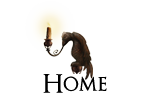Scribble City Central's twenty-second Fantabulous Friday creature is brought to us by Ellen Renner. When I read Ellen's debut novel, Castle of Shadows, I knew a powerful new voice had joined the world of children's literature, and its sequel, City of Thieves confirmed me in that belief. Ellen's slightly skewed historical world has flavours of both Aiken and Peake, with a touch of steampunkery, but is entirely her own, and her main characters are people you come to care about deeply by the end of both books. Now I am terribly excited to hear that Ellen has embarked on a new project. Called Tribute, it is coming from Hot Key Books in March 2013, and is about a young mage called Zara, who lives in a world where magic is power, technology is banned - and reading can get you killed. I'm already salivating at the thought of it, and although she says below that she's scared to death during the writing process, I'm pretty sure she'll come out the other side with her vorpal sword shining with the powerful blood of her words. Which brings me neatly to the subject of Mr Lewis Carroll's creation. Ellen and I share a love for Carroll's poem - it's always been one of my favourites. Let's see what she has to say about the scary
J for Jabberwock
Denizen of the Slithy Toves
Jabberwocky from Through the Looking Glass, and What Alice Found There by Lewis Carroll
'Twas brillig, and the slithy toves
Did gyre and gimble in the wabe;
All mimsy were the borogoves,
And the mome raths outgrabe.
"Beware the Jabberwock, my son!
The jaws that bite, the claws that catch!
Beware the Jubjub bird, and shun
The frumious Bandersnatch!"
He took his vorpal sword in hand:
Long time the manxome foe he sought—
So rested he by the Tumtum tree,
And stood awhile in thought.
And as in uffish thought he stood,
The Jabberwock, with eyes of flame,
Came whiffling through the tulgey wood,
And burbled as it came!
One, two! One, two! and through and through
The vorpal blade went snicker-snack!
He left it dead, and with its head
He went galumphing back.
"And hast thou slain the Jabberwock?
Come to my arms, my beamish boy!
O frabjous day! Callooh! Callay!"
He chortled in his joy.
'Twas brillig, and the slithy toves
Did gyre and gimble in the wabe;
All mimsy were the borogoves,
And the mome raths outgrabe.
ER: Jabberwocky is probably the most famous nonsense poem written in the English language – a piece of quintessentially Victorian whimsy. Except it isn't – or not merely so. It's constructed from the same cloth as Lewis Carroll's other nonsense poems in the Alice books: the divinely funny 'You Are Old, Father William' and 'How Doth the Little Crocodile' and 'The Mouse's Tale'.
In writing the Alice books, Carroll was indulging the late Victorian-cum-Edwardian fashion for sugar-coated fantasy; for fairies in the garden, owls and pussycats, Jumblies and Neverlands. But the best of these confections contain a dark core. Artists are children at heart: they know how to play, and play hard. The Alice books leap past self-conscious whimsy and land smack-dab in the middle of originality, a territory only found by asking 'what if' fearlessly and seeing where it takes you. Lewis Carroll was unafraid of that most terrifying of things: his own imagination.
I first read the Alice books as a child of nine or ten and found the world they took me to enchanting and terrifying in equal measure. I became a life-long Alice fan, although I do remember that long-ago child feeling cheated by the 'just a dream' end of both books. A reader doesn't want to experience a world intensely only to be told that it doesn't exist, that it was all merely a dream and Alice is just an ordinary girl after all, and possibly a rather silly one.
For the child me, Alice was a hero. As an adult, I see that the books are all about her slightly stupid and very English refusal to be discomposed. She is as much a fantastical creature as the Cheshire Cat or the the hookah-smoking Caterpillar. The nine-year-old me only knew that I – any real child – would have crept cowering and timorous through the labyrinthine madness of the Alice-worlds, desperate for a glimpse of something normal, familiar, sensical. Not so Alice. She is at one with the world of her imagination. As a child with too great an aptitude for 'what-if' (i.e.: frightened of everything), that struck me as nothing short of miraculous. Alice has all the bravery of the truly unimaginative mind and therein lies the humour and joy of these books.
I remember the poem, Jabberwocky, as a dark moment of real fear at the heart of Through the Looking Glass. Reading it now, it's hard to see exactly what I found so frightening, but I think it was the picture conjured in my mind by Carroll's glorious 'portmanteau' words: slithy, frumious, bandersnatch, uffish, wiffling, tulgy, snicker-snack.
Then, of course, there was Tenniel's illustration – all nightmare rubber-necked, beclawed and bewinged, open-mouthed icky-ness. Now I note the humour in the incongruity of the fish face with it's gawping mouth, the dangling over-sized hands and correctly buttoned waistcoat.
But the nine-year-old me became that young androgynous figure wielding a blade as long as myself, quaking in my doublet-and-hose as I faced a drooling (surely, it must drool) Jabberwock. Would my blade snatch victory, snicker-snack? Would its edge be stained with green Jabberwock gore ... or would I end an untidily eaten meal, disappearing into that oddly rabbit-toothed maw?
So what does the Jabberwock mean to me a life-time later as a working writer? It symbolises the purpose of story, which is to kill the monster. Story is not reality. Story is about shaping reality, about creating order from chaos. The Jabberwock is fear itself. It's whatever we have to overcome to do what we need to do, and is therefore the monster all writers face every time they sit down at their keyboard.
Insecurity stalks most writers. When I had the idea for Castle of Shadows, it took a great deal of courage to sit down and give it my all. Castle started as a fairy-tale: a mad king, a missing queen, an evil prime-minister. It would have been so easy to play safe and write a whimsical little fable. Instead, I decided to risk failure to try to write about power, politics, and a lonely child's quest to save her father. I didn't know if I was a good enough writer to write the sort of book I loved reading, but I did know true failure lay in not trying.
Castle and the sequel, City of Thieves, are now out in the world and doing well and I've moved on. My current project, Tribute, is another challenge. I'm pushing my limits, and am scared to death once again. For me, that's what writing about: not playing safe. That's when you get your best work done, when you stand armed with the vorpal blade of your imagination and face your own personal Jabberwock.
Story has always existed; it always will. The novel as a literary form may run its course. The technology by which we transmit story will inevitably change the form story takes. None of that frightens me; I know story will continue. We need it now as much as our ancestors did: those who drew on the walls of the caves at Lascaux fighting the monster of hunger; the misguided quest for eternal life as told in the Epic of Gilgamesh; Beowulf's defeat of Grendel, that monstrous incarnation of evil. We cannot live without story – it explores what it means to be human. Stories create us as much as we create them. And in so doing, they make life possible. Long live the Jabberwock and those who battle it. O frabjous day! Callooh! Callay!
SCC: Thanks so much, Ellen, that was fascinating. I think many writers will relate to the idea of facing one's own personal Jabberwock during the creative process. I know I do.
Can't wait to read Ellen's books? Why not buy them right now from The Scribble City Central Bookshelf? Just click on the link!
Next week: Kevin Crossley-Holland, multi-award winning author and current President of the School Library Association talks about J for Jormungandr, The Midgard Serpent. See you then!
































